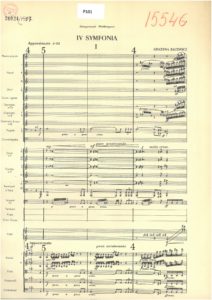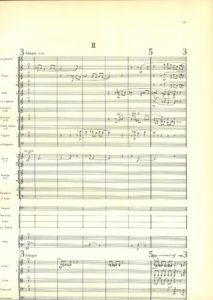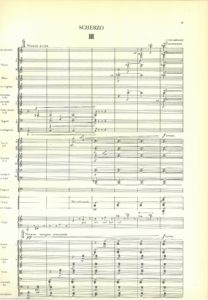Symphony No. 4, composed in 1953, is the last orchestral work by Grażyna Bacewicz with such a title. Her later, cyclic pieces composed for a similar instrumental line-up received different names. We could say that the composer decided that the cycle of her post-war symphonies represented a completed stage of her creative journey. The largest work of the kind, Symphony No. 4, was written at the height of the socialist realism doctrine and it is hard not to be asking: To what extent is this work, by a seasoned composer following her own path, burdened with ideology? The question is, indeed, difficult. It was asked by Tomasz Tarnawczyk in his article “Symfonie Grażyny Bacewicz na tle sytuacji społeczno-politycznej w powojennej Polsce” (Grażyna Bacewicz, Konteksty życia i twórczości, Łódź, 2016), rightly concluding that the lack of unequivocal criteria defining the socialist realist style made it possible to see Grażyna Bacewicz’s symphonies primarily as a “sign of the times, an expression of the composer’s authentic struggle with the musical craft treated with utmost seriousness.”
Symphony No. 4, dedicated to Grzegorz Fitelberg, consists of four movements and is written for large orchestra (3 flutes + piccolo, 2 oboes + cor anglais, E flat clarinet, 2 B flat clarinets, B flat bass clarinet, 2 bassoons + contrabassoon, 4 horns, 3 trumpets, 3 trombones, tuba, 4 timpani, snare drum, cymbals, gran cassa, harp and strings).
The first movement (Appassionato. Allegro inquieto) is a classic sonata allegro. Appearing after the Introduction (Appassionato), theme I (Allegro inquieto), with its unsteady measure (constant change from 2 to 3), and two-sentence structure (2 + 3), played in parallel minor thirds by the first and second violins, with an emphasis being put on the Phrygian second, is far removed from the “solemn” first themes of Bacewicz’s other works. This laconic theme is immediately developed, appearing in various forms and instrumental constellations. A transition built on a simple figure of two semiquavers and a quaver leads to the second theme (imitated successively by the bassoon, oboe, horns, quintet and flutes) with a motif from the folk song “Lecioły zórazie” from the Kurpie region (Szymanowski’s lasting influence?). Both themes are so distinctive that thematic work – consisting in juggling the theme motifs in a constantly changing agogic-dynamic aura – conforms to the traditional canon. A brief allusion to the Ballet of Unhatched Chicks from Mussorgsky’s Pictures at an Exhibition towards the end of the exposition adds colour to the movement.
The second movement (Adagio), similar to a passacaglia in its form, is – despite a brief allusion to the first part of Stravinsky’s The Rite of Spring in the cor anglais part – unequivocally tragic. As if to balance it out, the following movement, Scherzo (Vivace), full of delicious instrumentation ideas, brims with humour, mainly thanks to two very simple folk themes which constitute the basis for the movement.
The most mysterious is the fourth movement (Adagio mesto. Allegro furioso). The unison beginning of the strings, starting from ppp and splitting into second-based sounds coloured by short interventions of the horns and the harp, strangely brings to mind the climate of Henryk Mikołaj Górecki’s late works. But the Adagio mesto is transformed into the Allegro furioso. Never has an expression marking been so adequate for the sound content, clearly drawing on fragments of the finale of Béla Bartók’s Concerto for Orchestra. The climate of the last movement of Bacewicz’s Symphony No. 4 is even more “demonic” than the finale of Bartók’s masterpiece, but just as full of textural ideas making the work unique. The secondary theme, intoned by the strings (rubato misteriso, molto espressivo, no. 12), is, as Tomasz Tarnawczyk has rightly noted, a quasi-dodecaphonic series (the first nine notes appear without repetition). In the recapitulation (no. 25) the theme, intoned by the bass clarinet, appears is a residual form. Despite its unequivocally neoromantic expressive aura, flashes of a new, sonoristic thinking throughout the Symphony indicate the direction of the composer’s further development.
The premiere of Symphony No. 4 took place on 15 January 1954 in Kraków. The Orchestra of the Kraków Philharmonic was conducted by Bohdan Wodiczko.
- Symphony no. 4, PWM score, mov. 1
- Symphony no. 4, PWM score, mov. 2
- Symphony no. 4, PWM score, Scherzo


